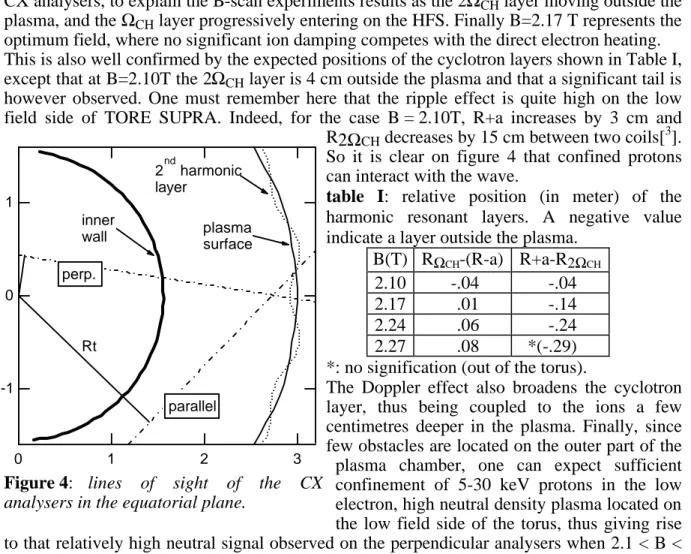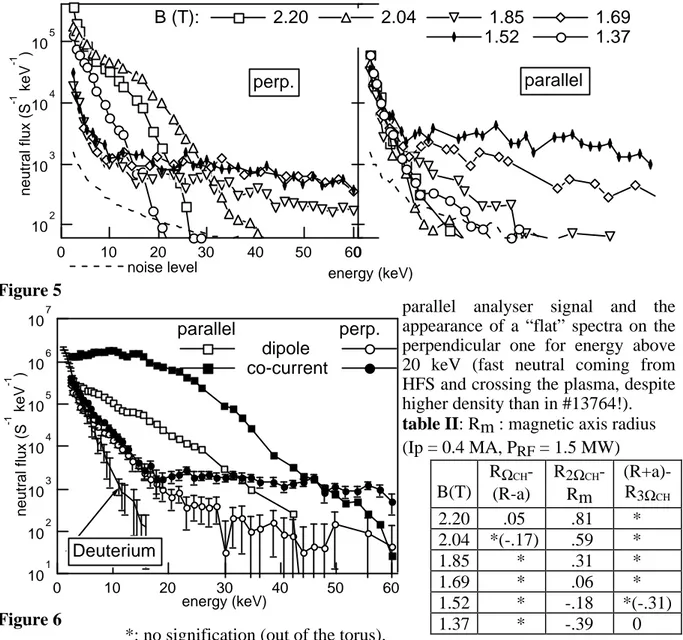HAL Id: hal-00001140
https://hal.archives-ouvertes.fr/hal-00001140
Preprint submitted on 13 Feb 2004HAL is a multi-disciplinary open access archive for the deposit and dissemination of sci-entific research documents, whether they are pub-lished or not. The documents may come from teaching and research institutions in France or abroad, or from public or private research centers.
L’archive ouverte pluridisciplinaire HAL, est destinée au dépôt et à la diffusion de documents scientifiques de niveau recherche, publiés ou non, émanant des établissements d’enseignement et de recherche français ou étrangers, des laboratoires publics ou privés.
Ion energy balance during fast wave heating in TORE
SUPRA
Thierry Hutter, Alain Bécoulet, Jean-Pierre Coulon, Vincent Saoutic, Vincent
Basiuk, G.T. Hoang
To cite this version:
Thierry Hutter, Alain Bécoulet, Jean-Pierre Coulon, Vincent Saoutic, Vincent Basiuk, et al.. Ion energy balance during fast wave heating in TORE SUPRA. 2004. �hal-00001140�
Ion energy balance during fast wave heating
in TORE SUPRA
T. Hutter, A. Bécoulet, J.P. Coulon, B. Saoutic, V. Basiuk, G. T. Hoang
Association Euratom-CEA sur la Fusion Centre d'Etudes de Cadarache 13108 Saint Paul Lez Durance (FRANCE)
Introduction
Direct coupling of the fast magnetosonic wave to the electrons has been recently studied on TORE SUPRA. Preliminary experiments were dedicated to optimise the scenario for Fast Wave Electron Heating (FWEH) and Current Drive (FWCD). In a first part, thermal kinetic and diamagnetic energy are compared when fast wave is applied to the plasma in two different regimes: 1/ the minority hydrogen heating scenario (ICRH), 2/ the direct electron damping. Effects of ion resonant layers, marginally present in the plasma in the later regime (FWEH), is then presented and discussed.
In the following, all plasmas are limited on the carbon inner wall, with R = 2.28 m and a = 0.72 m, and, unless specified, are helium plasmas with a small hydrogen concentration (nH/ne < 5%).
Thermal energy content
On TORE SUPRA, time resolved energy spectra of fast hydrogen and deuterium neutrals are routinely measured by charge exchange (CX) analysers [1] of the E||B type (46 channels per mass, H and D, Emax = 300 keV) with different lines of sight: five in a poloidal cross-section having a tangency radius Rt = 0.43 m (near “perpendicular”), and one in the equatorial plane with Rt = 1.9 m (near “parallel” to the magnetic axis, see figure 4).
Concerning the ion energy balance, the ion temperature profiles are simulated including: 1/ a best fit to the passive measured spectra of each analyser, 2/ for all the analysers, the same normalisation factor for the neutral density profile (fast computed consistently with ion temperature[2]) and 3/ the consistency with neutron yield and plasma composition. Standard diagnostics provide the other experimental data required in the simulation code (ne(r), Te(r), Zeff, neutron yield and plasma geometry). A 4-step electron density scan is performed on a 4 s, 4 MW ICRH pulse (f = 57.4 MHz, dipole phasing), launched in a mainly deuterium plasma (nD/nHe 2, B = 3.9 T, Ip=1.3 MA). Electron and ion kinetic thermal energies are shown on figure 1. In the ohmic phase, diamagnetic and kinetic energy are found in good agreement. The lowest density point corresponds to a monster sawtooth. For the other points, data are averaged during 100 ms (about two normal sawteeth). If we assume that perpendicular supra-thermal ion energy content is the difference between diamagnetic and thermal kinetic energy, it is within the error bars for the high density point, but clearly increases with decreasing density. The thermal energy content has also been evaluated on a 4 MW pulse of FWCD (f = 47.7 MHz, co-current phasing) launched in mainly helium plasma (nD/nHe 0.7, B = 2.2 T, Ip = 0.76 MA). It is
0.7 0.6 0.5 0.4 0.3 0.2 0.1 0.0 energy (MJ) 3.0 2.5 2.0 1.5 <ne> (10-19 m-3) total electrons ions diamagnetic: thermal kinetic: Figure 1
found equal to the diamagnetic energy, indicating that the supra-thermal particle energy content, if present, is negligible.
Hydrogen spectra during FWEH optimisation
To get a better efficiency for FWEH/CD, it is necessary to avoid any ion damping of the wave. Due to the outgasing of the TORE SUPRA carbon inner wall, it is impossible to get rid of hydrogen and deuterium. A precise monitoring of the position of the ion cyclotron layers is thus a necessity. The CX analysers, both parallel and perpendicular, appear to be the best tool to optimise the scenarios. For f=47.7 MHz (dipole phasing, 2MW, 2s), the magnetic field B has been scanned between 2.10 and 2.27 T on four consecutive shots (Ip = 0.75MA). The first harmonic hydrogen layer, ΩCH, is on the high field side (HFS) of the discharge, the
second one, 2ΩCH, on the low field side (LFS), and the third harmonic of majority ions
(deuterium or helium, 3ΩCD) is at the plasma centre. In the present plasma conditions, no
significant damping on 3ΩCD is expected. This is experimentally confirmed by the usual maxwellian shape of the observed deuterium spectra (figure 6). Hydrogen neutral spectra measured during these shots (analysers time resolution: 65 ms) are shown on figure 2. One
can notice that the perpendicular tail vanishes when increasing B from 2.1 to 2.24 T, and that above 2.2 T a large non maxwellian tail appears on the parallel analyser.
An ion of velocity v directed towards the CX analyser (and of parallel velocity v//), making a CX at major radius Rcx, satisfies Rt/Rcx = v// / v. According to the adiabatic theory of particle trajectories in tokamak, this ion, before the CX, can cross a cyclotron resonant layer (nΩCH,
n=1,2,...) only if Rcx - Rt2 / Rcx ≤ RnΩCH. The equality corresponds to
a trapped ion with banana tips on the resonant layer, which interacts strongly with the wave. The corresponding value of Rcx is shown on figure 3 for each harmonic layer present in the plasma (1.56 < RnΩCH < 3.2). One
can check that, in the present B-scan, particles interacting with the ΩCH layer can be detected
by the parallel analyser when doing their CX on the LFS and by the perpendicular analyser when doing their CX on the HFS. However the energy of the ions in the present case is low
102 103 104 105 106 neutral flux (s -1 keV -1 ) 30 20 10 0 0 B (T) 2.10 2.17 2.24 2.27 perp. parallel energy (keV) Figure 2 3.0 2.5 2.0 1.5 CX location Rcx (m) 2.2 2.0 1.8 1.6 1.4 toroïdal field (T) perp. parallel 1st harmonic 2ndharmonic 3rd #13764-74 Figure 3
(E<20keV, cf. figure 2). The particles making their CX on the HFS are thus mostly re-ionised before reaching the perpendicular analyser. The ions accelerated on ΩCH (HFS) are then
mainly detected by the parallel analyser. And in the same way, the perpendicular analyser mainly detects the ions accelerated on the 2ΩCH (LFS) layer. It is thus possible, using both
CX analysers, to explain the B-scan experiments results as the 2ΩCH layer moving outside the
plasma, and the ΩCH layer progressively entering on the HFS. Finally B=2.17 T represents the
optimum field, where no significant ion damping competes with the direct electron heating. This is also well confirmed by the expected positions of the cyclotron layers shown in Table I, except that at B=2.10T the 2ΩCH layer is 4 cm outside the plasma and that a significant tail is however observed. One must remember here that the ripple effect is quite high on the low field side of TORE SUPRA. Indeed, for the case B = 2.10T, R+a increases by 3 cm and R2ΩCH decreases by 15 cm between two coils[3].
So it is clear on figure 4 that confined protons can interact with the wave.
table I: relative position (in meter) of the
harmonic resonant layers. A negative value indicate a layer outside the plasma.
B(T) RΩCH-(R-a) R+a-R2ΩCH
2.10 -.04 -.04 2.17 .01 -.14 2.24 .06 -.24 2.27 .08 *(-.29) *: no signification (out of the torus).
The Doppler effect also broadens the cyclotron layer, thus being coupled to the ions a few centimetres deeper in the plasma. Finally, since few obstacles are located on the outer part of the plasma chamber, one can expect sufficient confinement of 5-30 keV protons in the low electron, high neutral density plasma located on the low field side of the torus, thus giving rise to that relatively high neutral signal observed on the perpendicular analysers when 2.1 < B < 2.2 T (2ΩCH, upper right black square on figure 3).
Ion-electron competitions during FWEH/CD experiments
A larger B-scan has been performed (1.37<B(T)<2.2), at f=47.7MHz, in order to investigate the possibility for maximizing the electron single-pass absorption (which scales as B-3). But lowering B also means entering the 2ΩCH layer into the plasma, and thus a
competition with ion damping (which increase also with ion temperature Ti). Figure 5 displays the CX analysers measurements for various B values, the corresponding cyclotron layers locations being given in Table II. One clearly distinguish the increasing absorption on the 2ΩCH layer as it enters the plasma towards the centre (and experiences an increasing Ti, B
from 2.2 to 1.69T), followed by a decrease as B varies from 1.69 to 1.37T. The FW single-pass absorption computations, as well as full-wave simulations, confirm the observations, revealing a switch between the electron and ion dampings when the 2ΩCH layer is at the
plasma centre (B=1.69T).
Another example of such a competition between ions and electrons has been observed when phasing the currents between the FW antenna straps, for FWCD experiments. In that case, the averaged parallel wave number decreases, lowering the electron single-pass absorption. This is well confirmed by the neutral spectra measurements, in cases where the set -1 0 1 3 2 1 0 2nd harmonic layer plasma surface Rt parallel perp. inner wall
Figure 4: lines of sight of the CX
f / B is not optimised: for 48MHz / 2.25T, ΩCH layer is slightly inside the plasma on the high
field side. On figure 6, hydrogen spectra measured during FWEH for two different shots, with these f / B values, are presented. We can see that spectra remain low in dipole phasing (#13764), but with the co-current phasing (#13774), we observe a large increase of the
parallel analyser signal and the appearance of a “flat” spectra on the perpendicular one for energy above 20 keV (fast neutral coming from HFS and crossing the plasma, despite higher density than in #13764!).
table II: Rm : magnetic axis radius
(Ip = 0.4 MA, PRF = 1.5 MW)
*: no signification (out of the torus).
Conclusions
On TORE SUPRA CX analysers 1/ prove to be a powerful tool in the determination and optimisation of the FWEH/CD scenarios, 2/ permit direct observation of competing damping mechanisms for ions and electrons.
1 similar to those developed for TFTR: A. L. Roquemore et al., Rev. Sci. Instrum. 56,
1120 (1985).
2 H. Capes, P. Laporte, T. Hutter and J-C. M. de Haas, this conference. 3
R. Arslanbekov, Y. Peysson et al, this conference. 102 103 104 105 neutral flux (S -1 keV -1 ) 60 50 40 30 20 10 0 perp. noise level 0 parallel energy (keV) B (T): 2.20 2.04 1.85 1.69 1.52 1.37 Figure 5 101 102 103 104 105 106 107 neutral flux (S -1 keV -1 ) 60 50 40 30 20 10 0 energy (keV) parallel perp. dipole co-current Deuterium Figure 6 B(T) RΩCH- (R-a) R2ΩCH- Rm (R+a)- R3ΩCH 2.20 .05 .81 * 2.04 *(-.17) .59 * 1.85 * .31 * 1.69 * .06 * 1.52 * -.18 *(-.31) 1.37 * -.39 0

